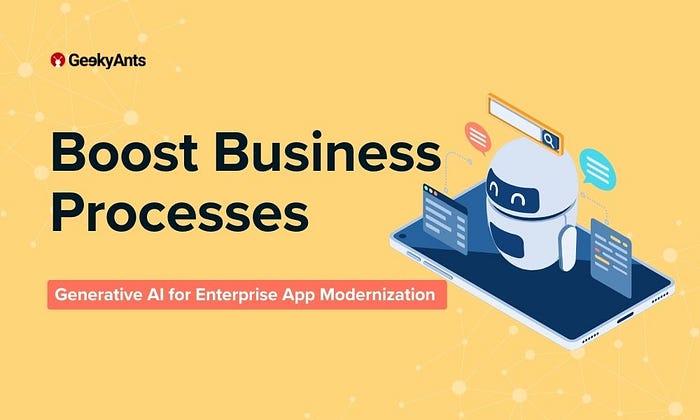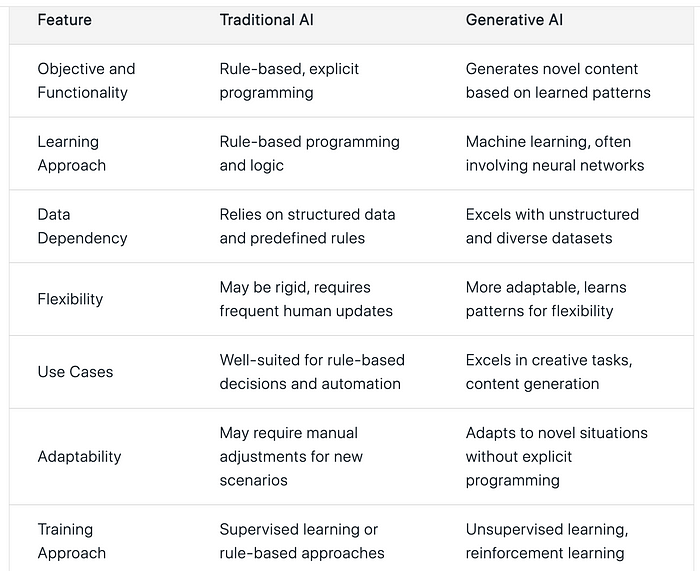

Generative AI in Enterprise Application Modernization
source link: https://blog.geekyants.com/generative-ai-in-enterprise-application-modernization-bbe691b45dd8
Go to the source link to view the article. You can view the picture content, updated content and better typesetting reading experience. If the link is broken, please click the button below to view the snapshot at that time.
Generative AI in Enterprise Application Modernization

Transforming legacy applications with Generative AI: learn how AI can automate code refactoring, enhance UI, ensure seamless data migration, and more.
When legacy applications malfunction, the security, compatibility, or overall efficiency challenges they create are the stuff of CTO and business leaders’ nightmares. Yet, cost of replacement, data migration and security risks, and lack of expertise are just a few reasons why some businesses still heavily rely on outdated or older information systems.
If you are into numbers, IBM conducted a survey where they asked executives to cite the major challenges to application modernization. Here is what they had to say:
57% of executives cite financial factors as a challenge, 51% of executives are challenged by technical factors, and 45% of executives say they are challenged by expertise factors.
When used correctly, AI-powered tools can help companies break out of this paradox and speed up business processes, reduce costs, increase profits, and offer superior customer service. In this article, we try to understand how.
Is Generative AI Really the Latest Solution to Application Modernization?
Traditional Vs. Generative AI
Traditionally, AI has assisted enterprises through task automation, predictive analytics, resource optimization, and cloud modernization. Generative AI is set to take this up a notch, creating new or fresh content using the data it is trained on.
As we can understand from the table shown below, generative AI’s capability to work with diverse datasets makes it more adaptive and flexible than traditional AI models.

So how does generative AI help businesses successfully transform legacy applications?
1. Automated Code Refactoring
Converting a legacy application to a modern architecture can be tricky. Generative AI can analyze and understand the existing codebase of legacy applications, offering a comprehensive app assessment. By leveraging machine learning algorithms, it can automatically generate refactored or optimized code, improving the application’s performance, readability, and maintainability. This can help businesses update their applications without a complete rewrite. This saves developers time, addresses technical debt, and reduces the chances of error.
2. Intelligent Code Generation
Generative AI not only refactors code but also intelligently generates new code segments based on learned patterns. This advanced code generation capability contributes to the creation of efficient, error-resistant code. By incorporating machine learning algorithms, it adapts to project requirements and coding standards, enhancing the overall quality and functionality of the application. ch and GitHub Copilot have been shown to elevate developer productivity and code quality.
3. Data Migration and Integration
Generative AI can aid in the automation of data migration processes when transitioning from legacy systems to modern architecture. It can help map and transform data structures, ensuring a smooth transition and minimising the risk of data loss or corruption. Generative AI can also assist in integrating legacy applications with newer technologies and platforms.
4. User Interface (UI) Modernization
As a company evolves, so does its design. Legacy applications often have outdated user interfaces that may not meet modern design standards. Generative AI can assist in automatically generating new UI elements, styles, and layouts to improve the user experience without requiring a manual redesign effort. The technology also ensures that the current best practices are followed, taking a load off designers’ shoulders.
5. Seamless Design-to-Code Transition
Generative AI facilitates a seamless transition from design to code implementation. By automating the translation of design elements into functional code, it minimizes manual intervention and reduces the likelihood of discrepancies between design intent and actual implementation. This ensures a smoother and more efficient development process, allowing developers to focus on high-level design aspects while the AI handles the intricate details of code implementation.
6. Code Testing and Maintenance
By automating aspects of the testing workflow, generative AI assists in identifying potential issues, ensuring the reliability and robustness of the refactored code. The technology even provides valuable insights for ongoing maintenance, offering suggestions for improvements and optimizations. This streamlining of the testing and maintenance phases contributes to a more efficient and sustainable software development lifecycle. Generative AI models can analyse historical data from legacy applications to predict potential issues or bottlenecks. This enables proactive maintenance and helps prevent system failures, improving overall reliability and reducing downtime.
7. Receiving Context-aware Responses
Introducing Natural Language Processing or NLP capabilities into legacy applications can enhance their functionality. Generative AI can be used to integrate natural language understanding and generation, allowing users to interact with the application through speech or text and receive more context-aware responses. This elevates user engagement and opens avenues for personalised experiences as the application adapts to individual communication styles.
8. Enhanced Security
Generative AI can contribute to strengthening the security of legacy applications by identifying and patching vulnerabilities. It can analyse code for potential security risks, suggest improvements, and even generate secure code patterns. Generative AI can assist in automating compliance monitoring and reporting, ensuring that enterprise applications adhere to industry regulations and standards. This reduces the risk of non-compliance and associated legal and financial consequences.
Some Benefits of Enterprise Application Modernization With Generative AI
Enterprise application modernization using AI can bring several key benefits, enhancing an organization’s efficiency, flexibility, and competitiveness. Here are a few significant advantages :
1. Improved Operational Efficiency
AI-powered modernization can automate routine and time-consuming tasks, reducing manual efforts and improving operational efficiency. This allows employees to focus on more strategic and value-added activities.
2. Enhanced User Experience
AI can enable personalized user experiences by analyzing user behavior, preferences, and historical data. This leads to tailored interfaces, content, and recommendations, enhancing user satisfaction and engagement. Integrating NLP capabilities can improve user interactions with enterprise applications. Chatbots, voice commands, and language understanding capabilities contribute to a more intuitive and user-friendly experience.
3. Data-Driven Decision-Making
AI can analyze large datasets quickly and provide valuable insights. Predictive analytics allows organizations to make informed decisions based on historical and real-time data, contributing to more accurate forecasting and strategic planning. AI-driven modernization enhances the capabilities of business intelligence tools, enabling organizations to extract meaningful insights from complex data sets, visualize trends, and make data-driven decisions.
4. Enhanced Security and Compliance
AI can contribute to improved cybersecurity by employing behavioral analytics and anomaly detection. It helps identify unusual patterns or potential security threats, allowing organizations to respond proactively to security incidents.
Like Any New Technology, Generative AI is Not Without its Challenges
The implementation of AI in legacy applications introduces potential risks, such as compatibility issues, where AI may struggle to integrate seamlessly with outdated systems. Security concerns also arise as legacy applications may lack the necessary safeguards to protect against evolving cyber threats. The risk of biased decision-making emerges if AI algorithms are not carefully trained or if they inherit biases present in the legacy data.
Striking a balance between modernization and risk mitigation becomes crucial to harness AI’s benefits while safeguarding legacy systems’ stability and integrity.
How Does GeekyAnts Fit Into the AI Application Modernization Picture?
Why Modernize Now?
Today, technology is evolving faster than you can say “generative AI,” making it necessary to acquire and implement modern skills necessary to stay ahead of the competition.
Recent studies suggest that more than 80% of business leaders believe companies with advanced generative AI will gain a significant competitive advantage in the coming years.
With the right implementation and clear understanding, generative AI can be a valuable ally in your app modernization journey.
How We at GeekyAnts Can Help
At GeekyAnts, we play a pivotal role in helping enterprises manage and modernize legacy systems by offering a range of specialized services and expertise.
Here is How We Do It
- Assessment and Planning: We help evaluate, collaborate, and chart a customized modernization roadmap aligned with your business goals.
- Technology Consulting: Navigate the modernization landscape with guidance from our teams and stay ahead with insights into emerging technologies.
- Customized Solutions: Our tailor-made solutions leverage cloud computing, microservices, and containerization for optimal scalability and efficiency.
- Data Migration and Integration: Automate your transition with precision, ensuring a smooth migration while seamlessly integrating new technologies.
- UI/UX Design: Elevate user experiences through redesigned interfaces adhering to modern standards and responsive design principles.
- Security and Compliance: Fortify your systems with our comprehensive security assessments, robust measures, and unwavering compliance assurance.
- Agile Development Practices: Embrace agility and innovation through our adoption of agile methodologies and DevOps practices.
- Continuous Support: Experience peace of mind with our ongoing support and maintenance. We address issues promptly and ensure sustained system stability.
Leverage our experience in generative AI guidance and strategic planning to experience an effortless transition in your application modernization process.
Recommend
About Joyk
Aggregate valuable and interesting links.
Joyk means Joy of geeK